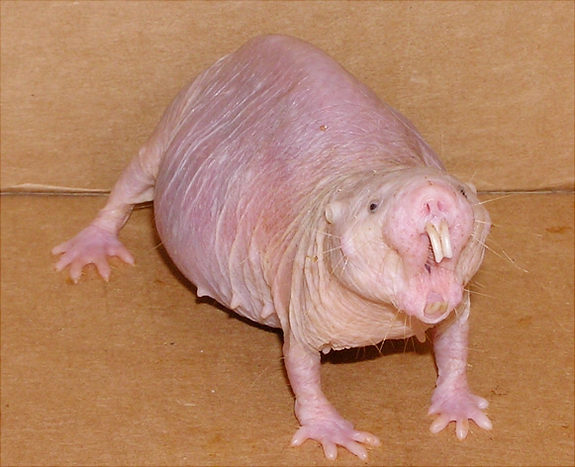Nature has a unique way of surprising us with its vast array of creatures, each uniquely adapted to their environment. Among the many wonders of the animal kingdom, the naked mole rat (Heterocephalus glaber) stands out as a unique and fascinating species. Living in the dry regions of East Africa, these small, hairless rodents have attracted the attention of scientists and enthusiasts due to their extraordinary characteristics and social structure.
Physical traits:
At first glance, the naked mole rat may seem unusual and even somewhat ridiculous. Due to its wrinkled, pink skin and protruding incisors, it lacks the fur that is characteristic of most rodents. Despite their appearance, these creatures are highly adapted to their underground lifestyle. Their lack of hair helps them move through tunnels without collecting mud, and their sensitive hair-like hairs serve as tactile sensors in the dark, tight spaces where they live.
Underground residents:
Naked mole rats are true subterranean specialists, spending their entire lives underground in complex burrow systems. These burrows can extend for several kilometers and contain chambers for various purposes such as nesting, food storage, and waste disposal. Remarkably, these rodents have evolved to thrive in environments with low oxygen levels and high carbon dioxide concentrations, conditions that would be challenging or lethal for many other mammals.
Social structure:
One of the most interesting aspects of naked mole rats is their highly organized and cooperative social structure. They live in colonies that are led by a breeding female, known as the queen, who is the only female to reproduce. The majority of colony members are non-breeding individuals who work together to maintain and protect the colony. The cooperative behavior displayed by naked mole rats is rare in the animal kingdom and has sparked interest among scientists studying social dynamics and altruism.
Longevity and Cancer Resistance:
Naked mole rats have also attracted attention for their extraordinary longevity compared to other rodents. While most rodents have a relatively short lifespan, the naked mole rat can live for more than 30 years. Even more interesting is their apparent resistance to cancer. Despite their long lifespan, these rodents show an unusually low incidence of cancer, making them valuable subjects for cancer research. Scientists are studying the unique genetic and molecular mechanisms that contribute to their cancer resistance in the hope of discovering insights that may benefit human health.
Adaptation to harsh environments:
Living in the harsh conditions of East African deserts, naked mole rats have developed impressive adaptations to survive. Their ability to go long periods without water, efficient use of energy, and their resistance to certain types of pain have contributed to their success in their challenging environments.
The naked mole rat, with its distinctive appearance and remarkable adaptations, serves as a testament to nature's diversity and ingenuity. As scientists continue to uncover the secrets behind their longevity, social structure, and resistance to cancer, these tiny rodents may hold valuable lessons that may benefit human health and our understanding of biology. In the depths of East African burrows, the naked mole rat stands as testament to the miracles of evolution, showing that even the strangest-looking creatures can teach us profound lessons about life and survival.
Here are some interesting facts about him:
Underground residents:
Naked mole rats are burrowing rodents that spend their entire lives underground. They create extensive tunnel systems in the dry regions of East Africa, forming colonies with complex social structures.
Hairless Appearance:
Unlike most rodents, naked mole rats lack fur. Their skin is pink and wrinkled, making them appear almost naked. This lack of fur helps them move easily through tunnels without accumulating dirt.
Typical teeth:
Naked mole rats have large, protruding incisors that they use for digging and chewing. Their teeth are always growing and are kept in check by constantly gnawing on roots and tubers.
Social structure:
These rodents live in colonies with a hierarchical social structure. Each colony usually has one breeding female, known as the queen, who is the only breeding female. The remainder of the colony consists of non-reproductive individuals, including workers and soldiers.
Social behavior:
Naked mole rats display social behavior, similar to some insects such as ants and bees. Colony members work together to perform tasks such as foraging, nest maintenance, and defense. Non-reproductive individuals are sterile and assist the queen in raising her offspring.
Queen's dominance:
The queen is the dominant female of the colony and maintains her position through aggressive behavior. If the queen dies or is removed, a new female becomes the dominant reproductive individual.
Longevity:
Naked mole rats are known for their unusually long lifespans among rodents. They can live for more than 30 years, which is extraordinary compared to the relatively short lifespan of most small mammals.
Cancer Resistance:
Naked mole rats display remarkable resistance to cancer. Despite their long lifespan, they have a very low incidence of cancer. Scientists are studying their unique biology to understand the mechanisms behind this resistance.
Low metabolic rate:
These rodents have low metabolic rates, allowing them to survive on limited food resources. They can go without eating for long periods of time, and their efficient use of energy contributes to their ability to thrive in harsh environments.
Pain insensitivity:
Naked mole rats have a high tolerance for certain types of pain, which is thought to be an adaptation to their underground lifestyle. They show insensitivity to substances that would be painful to other mammals.
Excellent Navigator:
Despite their small eyes and poor vision, naked mole rats are excellent navigators in their dark underground habitats. They rely on their highly developed sense of touch using specialized hairs on their bodies.
Voice Communication:
Naked mole rats communicate through a variety of vocalizations, including chirps, squeaks, and low purring sounds. These vocalizations play an important role in coordinating activities within the colony.
.png)

Comments
Post a Comment